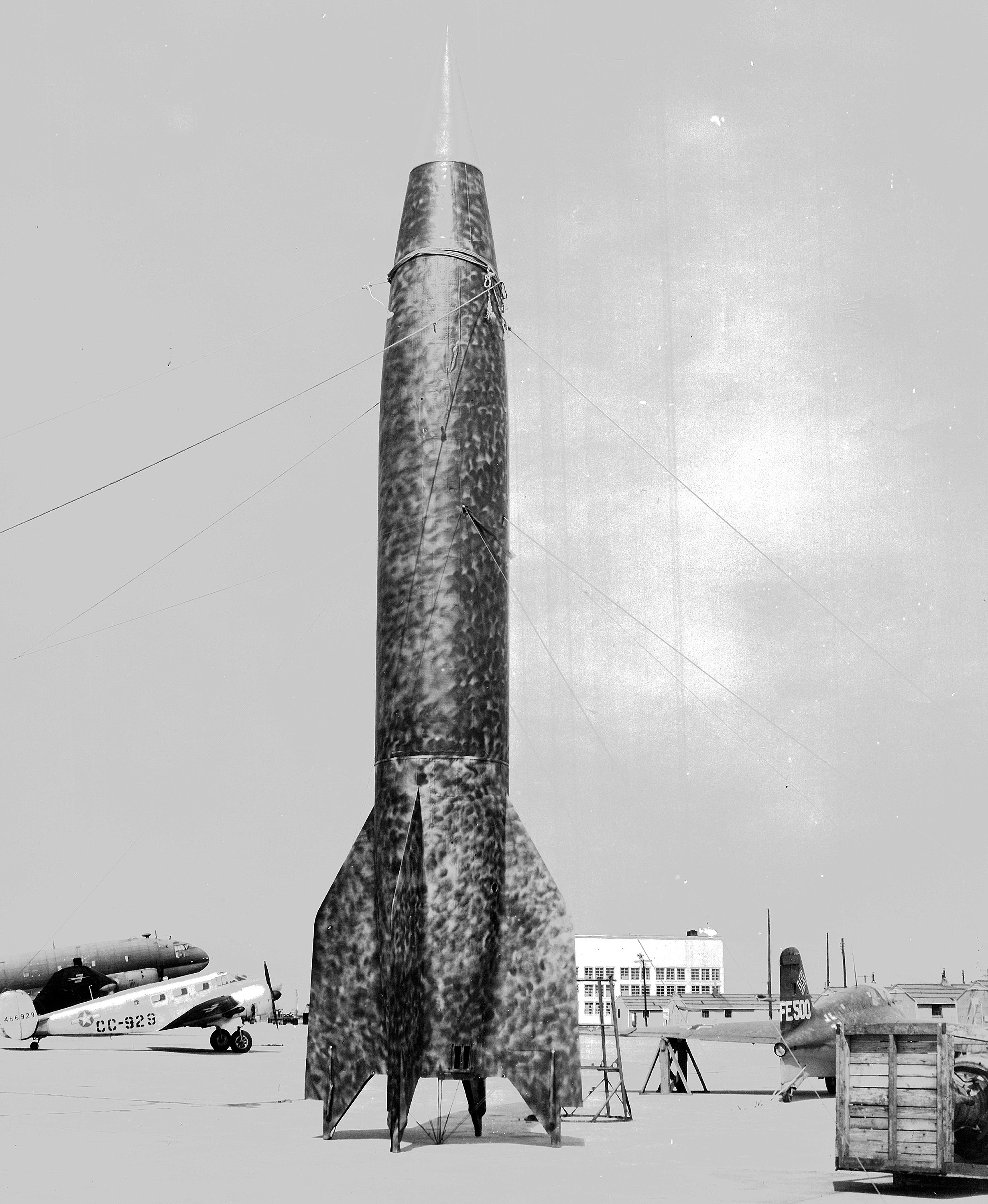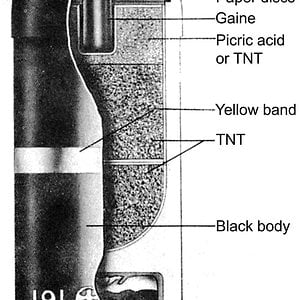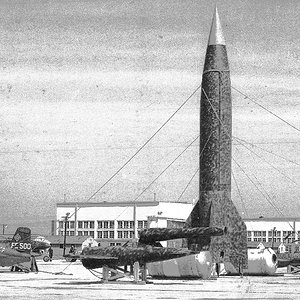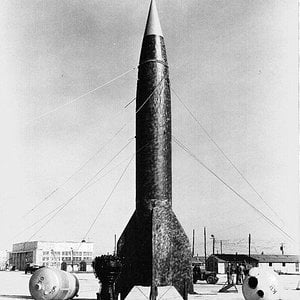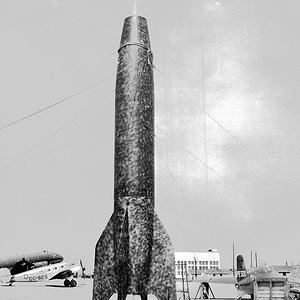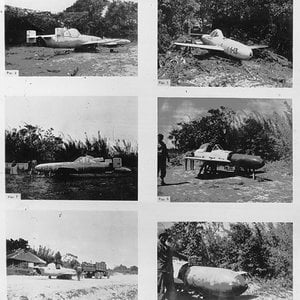Navigation
Install the app
How to install the app on iOS
Follow along with the video below to see how to install our site as a web app on your home screen.
Note: This feature may not be available in some browsers.
More options
You are using an out of date browser. It may not display this or other websites correctly.
You should upgrade or use an alternative browser.
You should upgrade or use an alternative browser.
Technical details
The A-4 used a 75% ethanol/water mixture for fuel and liquid oxygen (LOX) for oxidizer.[22]
At launch the A-4 propelled itself for up to 65 seconds on its own power, and a program motor controlled the pitch to the specified angle at engine shutdown, from which the rocket continued on a ballistic free-fall trajectory. The rocket reached a height of 80 km (50 mi) after shutting off the engine.[23]
The fuel and oxidizer pumps were steam turbines, and the steam was produced by concentrated hydrogen peroxide with sodium permanganate catalyst. Both the alcohol and oxygen tanks were an aluminium-magnesium alloy.[1]
The combustion burner reached a temperature of 2500–2700 °C (4500 – 4900 °F). The alcohol-water fuel was pumped along the double wall of the main combustion burner. This regenerative cooling heated the fuel and cooled the chamber. The fuel was then pumped into the main burner chamber through 1,224 nozzles, which assured the correct mixture of alcohol and oxygen at all times. Small holes also permitted some alcohol to escape directly into the combustion chamber, forming a cooled boundary layer that further protected the wall of the chamber, especially at the throat where the chamber was narrowest. The boundary layer alcohol ignited in contact with the atmosphere, accounting for the long, diffuse exhaust plume. By contrast, later, post-V2 engine designs not employing this alcohol boundary layer cooling show a translucent plume with shock diamonds.
Vanes at exit of exhaust
The V-2 was guided by four external rudders on the tail fins, and four internal graphite vanes at the exit of the motor. The LEV-3 guidance system consisted of two free gyroscopes (a horizon and a vertical) for lateral stabilization, and a PIGA accelerometer to control engine cutoff at a specified velocity. The V-2 was launched from a pre-surveyed location, so the distance and azimuth to the target were known. Fin 1 of the missile was aligned to the target azimuth.[24] Some later V-2s used "guide beams", radio signals transmitted from the ground, to keep the missile on course, but the first models used a simple analog computer that adjusted the azimuth for the rocket, and the flying distance was controlled by the timing of the engine cut-off, "Brennschluss", ground controlled by a Doppler system or by different types of on-board integrating accelerometers. The rocket stopped accelerating and soon reached the top of the approximately parabolic flight curve.
Dr. Friedrich Kirchstein of Siemens of Berlin developed the V-2 radio-control for motor-cut-off (German: Brennschluss).[15]:28,124 For velocity measurement, Professor Wolman of Dresden created an alternative of his Doppler[25]:18 tracking system in 1940–41, which used a ground signal transponded by the A-4 to measure the velocity of the missile.[2]:103 By 9 February 1942, Peenemünde engineer de Beek had documented the radio interference area of a V-2 as 10,000 meters around the “Firing Point”,[26] and the first successful A-4 flight on 3 October 1943, used radio control for Brennschluss.[14]:12 Although Hitler commented on 22 September 1943, that "It is a great load off our minds that we have dispensed with the radio guiding-beam; now no opening remains for the British to interfere technically with the missile in flight",[15]:138 about 20% of the operational V-2 launches were beam-guided.[14]:12 The Operation Pinguin V-2 offensive began on 8 September 1944, when Lehr- und Versuchsbatterie No. 444[25]:51–2 (English: Training and Testing Battery 444) launched a single rocket guided by a radio beam directed at Paris.[26]:47 Wreckage of combat V-2s occasionally contained the transponder for velocity and fuel cutoff.[13]:259–60
The painting of the operational V-2s was mostly a camouflage ragged pattern with several variations, but at the end of the war a plain olive green rocket also appeared. During tests, the rocket was painted in a characteristic black-and-white chessboard pattern, which aided in determining if the rocket was spinning around its longitudinal axis.
A U.S. Army cut-away of the V-2.
The original German designation of the rocket was "V2", unhyphenated, but U.S. publications such as LIFE magazine were using the hyphenated form "V-2" as early as December 1944.[27] This hyphenated form has now become common usage.
The A-4 used a 75% ethanol/water mixture for fuel and liquid oxygen (LOX) for oxidizer.[22]
At launch the A-4 propelled itself for up to 65 seconds on its own power, and a program motor controlled the pitch to the specified angle at engine shutdown, from which the rocket continued on a ballistic free-fall trajectory. The rocket reached a height of 80 km (50 mi) after shutting off the engine.[23]
The fuel and oxidizer pumps were steam turbines, and the steam was produced by concentrated hydrogen peroxide with sodium permanganate catalyst. Both the alcohol and oxygen tanks were an aluminium-magnesium alloy.[1]
The combustion burner reached a temperature of 2500–2700 °C (4500 – 4900 °F). The alcohol-water fuel was pumped along the double wall of the main combustion burner. This regenerative cooling heated the fuel and cooled the chamber. The fuel was then pumped into the main burner chamber through 1,224 nozzles, which assured the correct mixture of alcohol and oxygen at all times. Small holes also permitted some alcohol to escape directly into the combustion chamber, forming a cooled boundary layer that further protected the wall of the chamber, especially at the throat where the chamber was narrowest. The boundary layer alcohol ignited in contact with the atmosphere, accounting for the long, diffuse exhaust plume. By contrast, later, post-V2 engine designs not employing this alcohol boundary layer cooling show a translucent plume with shock diamonds.
Vanes at exit of exhaust
The V-2 was guided by four external rudders on the tail fins, and four internal graphite vanes at the exit of the motor. The LEV-3 guidance system consisted of two free gyroscopes (a horizon and a vertical) for lateral stabilization, and a PIGA accelerometer to control engine cutoff at a specified velocity. The V-2 was launched from a pre-surveyed location, so the distance and azimuth to the target were known. Fin 1 of the missile was aligned to the target azimuth.[24] Some later V-2s used "guide beams", radio signals transmitted from the ground, to keep the missile on course, but the first models used a simple analog computer that adjusted the azimuth for the rocket, and the flying distance was controlled by the timing of the engine cut-off, "Brennschluss", ground controlled by a Doppler system or by different types of on-board integrating accelerometers. The rocket stopped accelerating and soon reached the top of the approximately parabolic flight curve.
Dr. Friedrich Kirchstein of Siemens of Berlin developed the V-2 radio-control for motor-cut-off (German: Brennschluss).[15]:28,124 For velocity measurement, Professor Wolman of Dresden created an alternative of his Doppler[25]:18 tracking system in 1940–41, which used a ground signal transponded by the A-4 to measure the velocity of the missile.[2]:103 By 9 February 1942, Peenemünde engineer de Beek had documented the radio interference area of a V-2 as 10,000 meters around the “Firing Point”,[26] and the first successful A-4 flight on 3 October 1943, used radio control for Brennschluss.[14]:12 Although Hitler commented on 22 September 1943, that "It is a great load off our minds that we have dispensed with the radio guiding-beam; now no opening remains for the British to interfere technically with the missile in flight",[15]:138 about 20% of the operational V-2 launches were beam-guided.[14]:12 The Operation Pinguin V-2 offensive began on 8 September 1944, when Lehr- und Versuchsbatterie No. 444[25]:51–2 (English: Training and Testing Battery 444) launched a single rocket guided by a radio beam directed at Paris.[26]:47 Wreckage of combat V-2s occasionally contained the transponder for velocity and fuel cutoff.[13]:259–60
The painting of the operational V-2s was mostly a camouflage ragged pattern with several variations, but at the end of the war a plain olive green rocket also appeared. During tests, the rocket was painted in a characteristic black-and-white chessboard pattern, which aided in determining if the rocket was spinning around its longitudinal axis.
A U.S. Army cut-away of the V-2.
The original German designation of the rocket was "V2", unhyphenated, but U.S. publications such as LIFE magazine were using the hyphenated form "V-2" as early as December 1944.[27] This hyphenated form has now become common usage.

